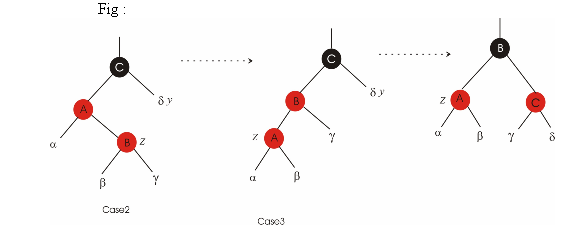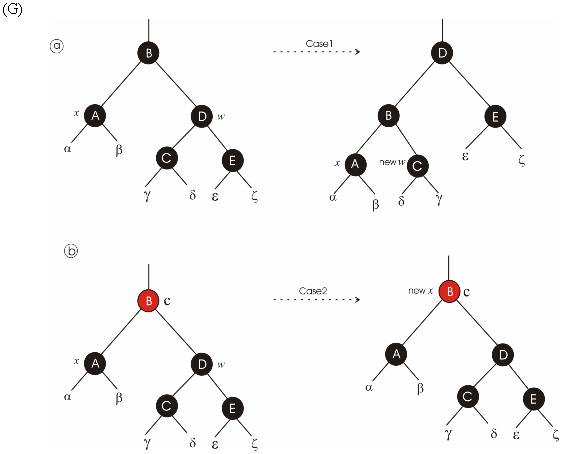a)
The algorithm will be as follows:
Initialize the array say A that has length n such that it is true for all values, then traverse the indices of the original array. If the corresponding entry in the array A is true, swap the element at the current index with the element at the bit reversed position.
Set the entry in the array A that corresponds to the bit-reversed index equal to false.
The function  is running
less than n times. So, the run-time is
is running
less than n times. So, the run-time is  .
.
1. do 
2 if 
3 then swap 
b)
The implementation of the BIT-REVERSED-INCREMENT procedure is as follows:
Do the bit reversed increment which will add a one to the left most position in which all carries will go to left instead of right.
BIT – REVERSED –INCREMENT 
1. let y be 1 followed by k-1 zeros.
2. while ( )
)
3. do
4. 
5. 
6. end while
7. return ( )
)
This algorithm will take amortized time. So, take a binary counter and bit reversed counter and swap the values of the two counters and perform increment.
If swapping has already been done, then do not swap.
The total running time of  BIT –
REVERSED –INCREMENT s is
BIT –
REVERSED –INCREMENT s is .
.
c)
If a word is shifted left or right by one bit in unit time, then it is still possible to implement O(n) time bit reversal permutation in the following way:
BIT – REVERSED –INCREMENT 
1. 
2. count 
3. while 
4. do 
 Shifts value
of x by only 1 bit left.
Shifts value
of x by only 1 bit left.
5. count  count +
1
count +
1
6. 
7. while (count > 0)
8. do 
 Shifts value
of x by only 1 bit right.
Shifts value
of x by only 1 bit right.
9. count = count – 1
 still holds.
still holds.
In this algorithm, only single shifts to the right or left are used.
a.
Consider the following algorithm to build an x rooted
tree which is  balanced:
balanced:
HALF-BALANCE-TREE 
1. Declare an array .
.
2. 
3. 
4. INSERT-NODE 
5. if
6. return.
7. HALF-BALANCE-TREE 
8. HALF-BALANCE-TREE 
Time complexity:
In above algorithm the 2nd line call the
INORDER-TRAVERSAL procedure to determine the in-order which takes
 time. The HALF-BALANCE-TREE procedure recursively call itself.
Therefore its recurrence becomes:
time. The HALF-BALANCE-TREE procedure recursively call itself.
Therefore its recurrence becomes:

Thus, time complexity becomes .
.
b.
In n-node  -balanced
binary tree the searching is done with the recursive calls. At any
point the sub-tree having i nodes make recursive call the
sub-tree having
-balanced
binary tree the searching is done with the recursive calls. At any
point the sub-tree having i nodes make recursive call the
sub-tree having  nodes.
Therefore the recurrence becomes:
nodes.
Therefore the recurrence becomes:

Where,  is the
constant, therefore total time taken by
is the
constant, therefore total time taken by  -balanced
binary tree in searching is
-balanced
binary tree in searching is .
.
c.
It is already given that potential of tree is:

Where, , is the
absolute difference between size of left and right sub-tree that is
why the binary search tree has non-negative potential. The
potential is non-negative because
, is the
absolute difference between size of left and right sub-tree that is
why the binary search tree has non-negative potential. The
potential is non-negative because  is the
absolute difference between size of left and right
sub-tree.
is the
absolute difference between size of left and right
sub-tree.
It is already known that in  balanced
binary search tree the size of left and right sub-tree is less
than
balanced
binary search tree the size of left and right sub-tree is less
than  the size
root x.
the size
root x.

and,

Now, prove  in
in
 balanced binary search tree by contradiction. At first
suppose
balanced binary search tree by contradiction. At first
suppose  .
.
This implies  ……
(1)
……
(1)
It is already known that sum of size of left sub-tree and right sub-tree is one less than size of its root tree.

Now, move size of left tree to RHS to determine value of

 …… (2)
…… (2)
Now, put size of right sub-tree in equation (1).

Move 2 to RHS

But, according to condition of  -balanced
search tree
-balanced
search tree , therefore
it’s a contradiction.
, therefore
it’s a contradiction.
This implies .
.
The potential is sum of all nodes over , but
according to above contradiction it is prove that there is no such
node.
, but
according to above contradiction it is prove that there is no such
node.
Therefore,  in
in  balanced search tree
balanced search tree
Suppose there is x-rooted m-node tree which is not
 -balanced.
This mean that it violets the property of
-balanced.
This mean that it violets the property of  -balanced
tree.
-balanced
tree.
Suppose size of left tree violets the property
 …… (3)
…… (3)
It is already known that the sum of size of left sub-tree and right sub-tree is one less than size of its root tree.

Using equation (3)

Take  as
common
as
common

Remove -1 from RHS

The difference in size of left and right sub-tree that is
 becomes:
becomes:

It is m-node tree therefore value of becomes
m
becomes
m

Take m as common

 …… (4)
…… (4)
Since,

Now, use equation (4)

So, when m-node is again rebuild into  balanced
tree then the potential at each node including root node must be 0.
Therefore potential change must be at least
balanced
tree then the potential at each node including root node must be 0.
Therefore potential change must be at least .
.
If value of constant c must be greater than  then the
potential will get reduce to m. Since, the potential to
rebuild a tree is m unit, the amortized cost of rebuilding
is
then the
potential will get reduce to m. Since, the potential to
rebuild a tree is m unit, the amortized cost of rebuilding
is 
Therefore, the value of constant must be  .
.
e.
In n-node  -balanced
BST the total amortized cost of insert and delete operation is the
sum of cost of insert or delete operation and the potential
difference between two states.
-balanced
BST the total amortized cost of insert and delete operation is the
sum of cost of insert or delete operation and the potential
difference between two states.
The cost of insert or delete operation is same as the cost of
searching a node in n-node  -balanced
BST.
-balanced
BST.
As per part (b), the cost of searching the node is . Therefore
the actual cost of insert and delete operation is also
. Therefore
the actual cost of insert and delete operation is also .
.
When a node x is inserted or deleted in tree then
 changes on
those ith node which comes in path from node x to
root. When insertion is occurred then
changes on
those ith node which comes in path from node x to
root. When insertion is occurred then  is increased
by 1.The
is increased
by 1.The of all other
remaining node get unchanged.
of all other
remaining node get unchanged.
According to part (b), the number of nodes to the location where
x is inserted is . Therefore
the change in potential becomes:
. Therefore
the change in potential becomes:

Remove the constant c

Therefore the total amortized cost of insertion or deletion:

SELF ORGANISING LISTS BY MOVE-TO-FRONT
By the name it suggests it is a type of list in which self-organizing is done in such a way that its elements are reordered on the basis of its heuristics such that the average access time improves. The main purpose of this method is to increase efficiency of the sequential search. And it is done by forwarding the items towards the head list which are frequently accessed. In the best case it takes the constant time for the accessing of element. It can be implemented easily by the linked-list. It is efficient in insertion and memory allocation of the random node but inefficient in its accesses.a. Suppose there is a list of n-elements
and an access sequence  of keys to
find elements, in order. In order to find any specific element in
list, traverse the list from beginning till element is not
found.
of keys to
find elements, in order. In order to find any specific element in
list, traverse the list from beginning till element is not
found.
The cost of accessing the sequence  using
heuristic is denoted by
using
heuristic is denoted by  and the
symbol m is for the number of access in
and the
symbol m is for the number of access in .
.
Now assume that there is a list L having n elements.
The sequence of  operations
which is provided one at a time and for each of the operations the
heuristics H must execute the operation immediately without
considering the future operations and it also look over the whole
sequence
operations
which is provided one at a time and for each of the operations the
heuristics H must execute the operation immediately without
considering the future operations and it also look over the whole
sequence  before.
before.
The worst case for Heuristic H on an access sequence is the access of the last (nth) element of list.
It is already mentioned that the cost of kth element of list is k.
Therefore the cost to access the nth element is n.
The cost of sequence is the summation of cost of each access. The numbers of access in sequence are m.
Hence, the cost of accessing the worst case using Heuristics H is

b. Move -to-front-Heuristics:
In this first find the element x in list and then
advances to the first position in the list. Here  is called
as the rank for the element x in the list L. The cost
of accessing sequence
is called
as the rank for the element x in the list L. The cost
of accessing sequence  is denoted
by
is denoted
by  using the move-to-front heuristics. Explaining
using the move-to-front heuristics. Explaining  with the
help of example that is if the element x is at
2nd position in the list then its rank is 2. It is
mentioned that the cost of finding xth element of
list is x which is equal to the rank of the element in the
list which is denoted by
with the
help of example that is if the element x is at
2nd position in the list then its rank is 2. It is
mentioned that the cost of finding xth element of
list is x which is equal to the rank of the element in the
list which is denoted by .
.
In the move-to-front heuristics after the accessing of the element x it is moved towards the front of L by the transpose operations.
Therefore, the cost of accessing the  key element
of list is the sum of cost of finding xth element
in list and cost of moving it to first position of list.
key element
of list is the sum of cost of finding xth element
in list and cost of moving it to first position of list.
The cost of finding xth element in list =
x or 
The cost of moving xth element of list to first is always one less than its rank like moving 4th element of list to first position requires 3 movements (4 to 3), (3 to 2) and (2 to 1).
Therefore,
The cost of moving xth element of list at
first position= 
The cost of accessing the key element
of list that is
key element
of list that is

Hence the condition for the cost is  .
.
c. The list after accessing of  with the
move-to-front technique is denoted by
with the
move-to-front technique is denoted by  and
and
 after the heuristics H.
after the heuristics H.
Correspondingly the cost of accessing the element is denoted by
 for the move-to-front technique and
for the move-to-front technique and  by the
heuristics H and it is also provided that the number of transpose
is
by the
heuristics H and it is also provided that the number of transpose
is  by the heuristics H.
by the heuristics H.
Since the cost for the ith operation in the move-to-front technique is,
 for the
accessing of the element x.
for the
accessing of the element x.
The list  is
reordered by transposing (changing the position of element) the
element of list. The cost of one transposition is one unit.
is
reordered by transposing (changing the position of element) the
element of list. The cost of one transposition is one unit.
It is already mentioned that the cost of finding
xth element of list is x which is equal to
the rank of the element in the list which is denoted by .
.
Therefore, the cost for accessing the xth element of list by the heuristics H is the sum of cost of accessing the xth element and number of transposition.

Where x = cost of accessing xth element.
 = number of
transposition.
= number of
transposition.
The cost of accessing the xth element is equal
to the rank of xth element which is denoted by


Hence proved
d. Inversion:
An inversion in the list  for a pair
of element y and z has done in such a way that
z is preceded by y in the list
for a pair
of element y and z has done in such a way that
z is preceded by y in the list  and
y is preceded by z in the list
and
y is preceded by z in the list  and the
number of inversion is denoted by
and the
number of inversion is denoted by . The
potential function
. The
potential function  maps list
maps list
 with number of inversions
with number of inversions .
.

Since

And

The list is reordered by transposing (changing the position of element) the element of list. The cost of one transposition is one unit.
And as the transpose used to either create or destroy the 1
inversion so the change in potential function is denoted by the
symbol  which is
equal to
which is
equal to .
.
e . To understand the effect of the access sequence on the potential function, define or classify the elements into four sets which are as follows:

Where as
 implies that
elements come before x in list
implies that
elements come before x in list  .
.
 implies that
elements come after x in list
implies that
elements come after x in list  .
.
Now considering the above sets it implies that the elements of
list are divided into four sets. Some element of list  which came
before x are in set A and remaining elements of list
which came
before x are in set A and remaining elements of list
 which came
before x are in set B.
which came
before x are in set B.
Therefore the total elements of list  before
x are the sum of set A and set B that is
before
x are the sum of set A and set B that is

The above sum of set A and B does not contain element x.
Therefore,

Rank that is  of element
is the position of x element in list.
of element
is the position of x element in list.
For example the rank of 6th element in list is 6 or the number of elements till 6th element including itself.
Hence,

Or

Similarly, all the elements of list  which come
before x are the sum of set A and set
C.Therefore
which come
before x are the sum of set A and set
C.Therefore

Or

When an element is accessed for a given operation, then,

|
|
|
|

|
|
|
|

|
|
|
|


|
|
|
|

Now considering the above access operation and its effect at the conclusion that

And
 .
.
f. Considering the part
(e) of the problem, the condition for
the change in potential as when using move-to-front technique the
x is moved forward that is in the front, it creates the
inversions which is equal to  and during
the process
and during
the process  inversions
are destroyed. And the transpose for the heuristics in which the
inversions created is less than equal to 1.
inversions
are destroyed. And the transpose for the heuristics in which the
inversions created is less than equal to 1.
So using the concept of the above discussion the change in potential is

The amortized cost is defined as the sum of the cost of the access sequence and the change in the potential function which can be represented for the ith operation with the move-to-front technique as

g. Proof of amortized cost  of access
being bounded by
of access
being bounded by 
In this problem amortized cost defined in the part (f) is as follows,

From part (b) and ( f),
Put  and
and


From part (e),
Put 

Add  on right
hand side of the equality
on right
hand side of the equality

Put 

As 
 Hence
proved
Hence
proved
h. Considering the part (g) of the problem the condition is as follow:




Where,  is the cost
of accessing using heuristics.
is the cost
of accessing using heuristics.



























